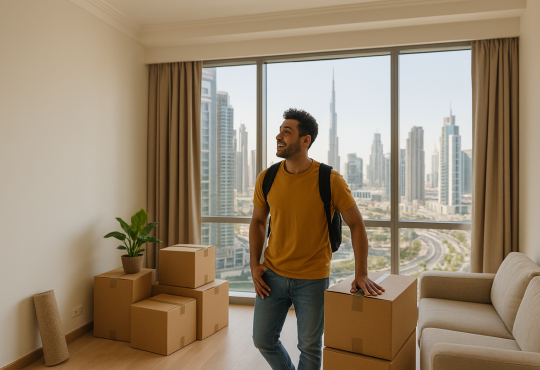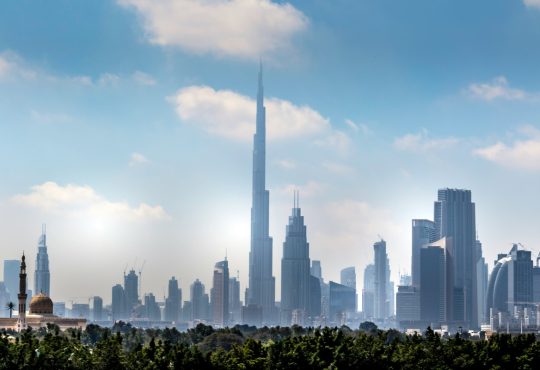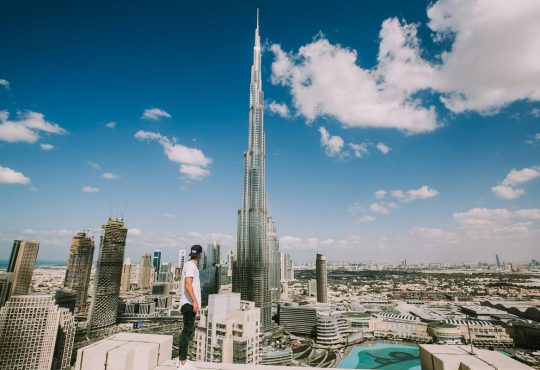
How to Travel Like a Pro in Dubai: A Complete Guide to Public Transportation

Dubai is a city that offers endless possibilities for visitors and residents alike. From its stunning skyscrapers and shopping malls to its cultural and historical attractions, there is something for everyone in this vibrant metropolis.
But how do you get around Dubai without breaking the bank or getting stuck in traffic? The answer is simple: use the public transportation system. Dubai has one of the most advanced and efficient public transportation systems in the Middle East, with a network of metro, bus, tram, and marine modes that cover the entire city.
Whether you want to visit the Burj Khalifa, the Dubai Mall, the Palm Jumeirah, or any other destination, you can easily reach it by using the public transportation system. In this blog post, we will show you how to navigate public transportation in Dubai like a pro.
- We will explain how to use the different modes of transport
- How to plan your journey
- How to buy tickets and fares
- The main stations and zones.
- Useful tips and resources to make your travel experience more enjoyable and convenient.
So read on and discover how to travel like a pro in Dubai.
The Different Modes of Public Transportation in Dubai
Dubai’s public transportation system consists of four main modes: metro, bus, tram, and marine. Each mode has its own advantages and disadvantages, depending on your destination, budget, and preference. Here is a brief overview of each mode:
- Metro:
This is the fastest and most convenient way to get around Dubai. The metro consists of two lines: the Red Line and the Green Line. The Red Line runs from Rashidiya to Jebel Ali, passing through major landmarks such as the Burj Khalifa, the Dubai Mall, and the Mall of the Emirates. The Green Line runs from Etisalat to Creek, passing through Deira and Bur Dubai. The metro operates from 5 am to midnight from Saturday to Thursday, from 5 am to 1 am on Friday, and from 8 am to 12 am on Sunday. The metro has air-conditioned stations and trains, free Wi-Fi, and dedicated cabins for women and children. - Bus:
This is the cheapest and most extensive way to get around Dubai. The bus network covers almost every area of the city, with over 150 routes and 1,500 buses. The buses are modern, comfortable, and equipped with air-conditioning, screens, and audio announcements. The buses operate from 4 am to 1 am (next day). The buses connect with the metro stations and other modes of transport, such as water buses and taxis. - Tram:
This is the newest and most eco-friendly way to get around Dubai. The tram consists of one line that runs from Al Sufouh to Jumeirah Beach Residence (JBR), passing through Dubai Marina and Media City. The tram operates from 6 am to 1 am from Monday to Saturday, and from 9 am to 1 am on Sunday. The tram has air-conditioned stations and trains, free Wi-Fi, and dedicated cabins for women and children. - Marine:
This is the most scenic and fun way to get around Dubai. The marine network consists of four modes: water bus, water taxi, abra (traditional wooden boat), and ferry. The water bus operates along the Dubai Creek and the Dubai Marina, offering a comfortable and affordable ride. The water taxi operates along the coast of Dubai, offering a personalized and flexible ride. The abra operates along the Dubai Creek and the Souk Madinat Jumeirah, offering a traditional and authentic ride. The ferry operates between various points along the coast of Dubai, offering a panoramic and luxurious ride.

How to Plan Your Journey Using Public Transportation in Dubai
Planning your journey using public transportation in Dubai is easy and convenient, thanks to the smart tools and services provided by the Roads & Transport Authority (RTA). The RTA is the official authority that manages and regulates all aspects of public transportation in Dubai. Here are some of the tools and services that you can use to plan your journey:
- Wojhati:
This is an online journey planner that helps you find the best route and mode of transport for your destination. You can access Wojhati here. You can also use Wojhati kiosks at metro stations or call 8009090 for assistance. - Metromap:
This is an interactive map that shows you the metro stations, lines, zones, fares, timings, facilities, and attractions. You can access Metromap here. You can also use Metromap kiosks at metro stations or scan the QR codes on the metro maps. - RTADubai:
This is the official mobile app of the RTA that offers a range of services and features for public transportation users. You can use RTADubai to plan your journey, buy and top up your tickets, check your balance, view your history, access live updates, and more. You can download RTADubai from the App Store or the Google Play Store.
How to Buy Tickets and Fares for Public Transportation in Dubai
Buying tickets and fares for public transportation in Dubai is simple and convenient, thanks to the smart payment systems and options offered by the RTA. The RTA has a unified fare system that applies to all modes of public transportation, except for water taxis and abras.
The fare system is based on zones, which are geographical areas that determine the cost of your trip. There are seven zones in Dubai, and the fare varies depending on the number of zones you cross. Here are some of the payment systems and options that you can use to buy tickets and fares:
- Nol Card:
This is a smart card that you can use to pay for all modes of public transportation, except for water taxis and abras. You can buy Nol Cards from ticket offices, ticket vending machines, authorized sales agents, or online. You can also use Nol Card to pay for parking, taxis, and some retail outlets. There are four types of Nol Cards: Silver, Gold, Blue, and Red.- The Silver Card is suitable for occasional users and costs AED 25 with AED 19 credit.
- The Gold Card is suitable for users who want to travel in the Gold Class cabins on the metro and tram, and costs AED 25 with AED 19 credit.
- The Blue Card suits students, senior Emiratis, and people of determination. The Blue Card costs AED 70 with AED 20 credit. You also get a 50% discount.
- The Red Card is suitable for one-time users or visitors who want to travel for a day or a week. The Red Card costs AED 2 and can be loaded with up to 10 trips or a daily or weekly pass.
- Apple Pay: This is a mobile payment service that allows you to use your iPhone or Apple Watch as a Nol Card. You can use Apple Pay to pay for all modes of public transportation, except for water taxis and abras. You can also use Apple Pay to pay for parking, taxis, and some retail outlets. You can set up Apple Pay on your device by adding your Nol Card or credit card details.

The Main Stations and Zones for Public Transportation in Dubai
Dubai’s public transportation system has many stations and zones that serve different areas and attractions in the city. Here are some of the main stations and zones that you should know:
- Union Station:
This is the largest and busiest station in Dubai, where the Red Line and the Green Line intersect. It is located in Deira, near the Dubai Creek. It serves many attractions such as the Gold Souk, the Spice Souk, the Al Ghurair Centre, and the Al Maktoum Bridge. - Burj Khalifa/Dubai Mall Station:
This is one of the most popular stations in Dubai, where you can access the Burj Khalifa, the Dubai Mall, the Dubai Fountain, and the Souk Al Bahar. It is located on the Red Line in Downtown Dubai. - Mall of the Emirates Station:
This is another popular station in Dubai, where you can access the Mall of the Emirates, Ski Dubai, Magic Planet, and Vox Cinemas. It is located on the Red Line in Al Barsha. - Jumeirah Lakes Towers Station:
This is one of the main stations in Dubai Marina, where you can access Jumeirah Lakes Towers (JLT), Dubai Marina Mall, Pier 7, and Marina Walk. It is located on the Red Line in JLT. - DAMAC Properties Station:
This is another main station in Dubai Marina, where you can access Dubai Marina Yacht Club, Marina Promenade, The Walk at JBR, and The Beach at JBR. It is located on the Red Line in Dubai Marina. - Al Sufouh Station:
This is the first station on the tram line, where you can access Madinat Jumeirah, Burj Al Arab, Wild Wadi Waterpark, and Jumeirah Beach Hotel. It is located on Al Sufouh Road. It is also connected to the metro station by a footbridge.
- Al Ghubaiba Station:
This is the main station for the water bus and the ferry, where you can access the Dubai Creek, the Heritage Village, the Al Shindagha Museum, and the Al Seef District. It is located in Bur Dubai, near the Al Ghubaiba Bus Station. - Al Jaddaf Station:
This is the main station for the water taxi, where you can access the Dubai Creek, the Dubai Festival City, the Dubai Creek Harbour, and the Ras Al Khor Wildlife Sanctuary. It is located in Al Jaddaf, near the Creek Metro Station.
The public transportation system in Dubai is divided into seven zones, which are:
- Zone 1: This covers Deira and Bur Dubai, including Union Station, Burjuman Station, Al Ghubaiba Station, and Al Jaddaf Station.
- Zone 2: This covers Sheikh Zayed Road and Downtown Dubai, including Burj Khalifa/Dubai Mall Station, Business Bay Station, and Financial Centre Station.
- Zone 3: This covers Al Barsha and Al Quoz, including Mall of the Emirates Station, First Abu Dhabi Bank Station, and Noor Bank Station.
- Zone 4: This covers Jumeirah and Umm Suqeim, including Noor Islamic Bank Station, First Gulf Bank Station, and Mall of the Emirates Station.
- Zone 5: This covers Dubai Marina and Jumeirah Lakes Towers (JLT), including DAMAC Properties Station, Jumeirah Lakes Towers Station, and Nakheel Harbour and Tower Station.
- Zone 6: This covers Jebel Ali and Discovery Gardens, including Ibn Battuta Station, Energy Station, and Jebel Ali Station.
- Zone 7: This covers Rashidiya and Mirdif, including Rashidiya Station, Emirates Station, and Terminal 3 Station.
Tips and Resources for Using Public Transportation in Dubai
Using public transportation in Dubai can be a rewarding and enjoyable experience if you follow some tips and use some resources that can help you along the way. Here are some of them:
- Plan your journey ahead of time using Wojhati or RTADubai to find the best route and mode of transport for your destination. You can also use Google Maps or other navigation apps that support public transportation options in Dubai.
- Buy your tickets and fares in advance using Nol Card, Nol Tag ID, or Apple Pay to avoid queues and hassle at the stations. You can also use cash or credit cards at ticket vending machines or ticket offices, but they may charge extra fees or have limited availability.
- Check the zones and fares before you travel to avoid paying extra. You can use Metromap or RTADubai to see the zones and fares for each mode of transport. You can also use Nol Card readers at the stations or on board to check your balance and deduct your fare.
- Follow the rules and etiquette of public transportation in Dubai to ensure a safe and comfortable ride. Some of the rules include:
- Validate your Nol Card or ticket at the entry and exit gates of the stations or on board of the buses or trams.
- Respect the priority seats and cabins for women, children, elderly, and people with disabilities.
- Do not eat, drink, smoke, or chew gum on board of any mode of transport or at the stations.
- Do not carry any prohibited items such as weapons, explosives, flammable materials, or pets on board of any mode of transport or at the stations.
- Do not litter or vandalize any mode of transport or at the stations.
Dubai is a city that offers a world-class public transportation system that can take you anywhere you want in a fast, convenient, and affordable way. By using the metro, bus, tram, or marine modes of transport, you can explore Dubai’s attractions and landmarks with ease and comfort.
Subscribe to our newsletter to stay up to date about the A to Zs of Dubai!



